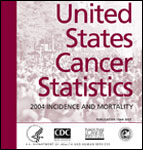Cancer Registries: Helping to Address the Nation's Cancer Burden
 State cancer registries, supported by CDC's National Program of Cancer Registries and the National Cancer Institute's Surveillance, Epidemiology, and End Results Program, collect data about cancer cases diagnosed and deaths from cancer to understand and address the nation's cancer burden.
State cancer registries, supported by CDC's National Program of Cancer Registries and the National Cancer Institute's Surveillance, Epidemiology, and End Results Program, collect data about cancer cases diagnosed and deaths from cancer to understand and address the nation's cancer burden.

Public health professionals need information about cancer cases diagnosed (called incidence) and deaths from cancer (called mortality) to understand and address the nation's cancer burden. State cancer registries, supported by CDC's National Program of Cancer Registries (NPCR) or the National Cancer Institute's Surveillance, Epidemiology, and End Results (SEER) Program, collect incidence data. Mortality data are collected by CDC's National Vital Statistics System.
NPCR supports cancer registries in 45 states, the District of Columbia, Puerto Rico, and the US Pacific Island Jurisdictions. These data represent 96% of the U.S. population. Together, NPCR and the SEER Program collect data for the entire US population.
 How Cancer Data Are Collected
How Cancer Data Are Collected
Medical facilities such as hospitals, doctor's offices, and pathology laboratories send information about cancer cases to their state cancer registry, where highly trained employees called registrars transfer the information from the patient's medical record to the registry's computer using standardized codes.
Every year, the state cancer registries submit incidence data to NPCR or SEER, which jointly release the United States Cancer Statistics: Incidence and Mortality (USCS) report. This report contains no identifying information about individual patients.
How Cancer Data Are Used
The data are used to—
- Monitor cancer trends over time.
- Show cancer patterns in various populations.
- Guide planning and evaluation of cancer control programs.
- Help set priorities for allocating health resources.
- Advance clinical, epidemiologic, and health services research.
 Vital information about cancer cases and cancer deaths is necessary for health agencies to report on cancer trends, find out whether cancer prevention and control efforts are working, participate in research, and respond to reports of suspected increases in cancer occurrence.
Vital information about cancer cases and cancer deaths is necessary for health agencies to report on cancer trends, find out whether cancer prevention and control efforts are working, participate in research, and respond to reports of suspected increases in cancer occurrence.
In addition to the USCS report, NPCR uses the data from state cancer registries for other research, including—
- The Breast, Colon, and Prostate Cancer Data Quality and Patterns of Care Study used registry data on about 7,600 patients diagnosed in 1997 to describe the patterns of care they received and their quality of treatment. The current Breast and Prostate Cancer Data Quality and Patterns of Care Study is building on previous work to examine patterns of care and the quality of treatment further. The study is being conducted in collaboration with seven registries across the country for about 24,000 patients diagnosed with breast or prostate cancer in 2004.
- The Annual Report to the Nation on the Status of Cancer, 1975–2005, Featuring Trends in Lung Cancer, Tobacco Use and Tobacco Control published jointly by the American Cancer Society, CDC, the National Cancer Institute, and the North American Association of Central Cancer Registries, includes cancer incidence rates, death rates, and trends in the United States. For the first time in the history of this report, both incidence and death rates for all cancers combined decreased for both men and women.
- Two supplements to the journal Cancer, one about the occurrence of human papillomavirus (HPV)-associated cancers in the United States, and one about cancer incidence in American Indians and Alaska Natives.
How States Are Using Cancer Registry Data
 California Cancer Registry Finds Need for Increased Cancer Screening
California Cancer Registry Finds Need for Increased Cancer Screening
The California Cancer Registry (CCR) identified local areas where 20% or more colorectal (colon) cancer cases were diagnosed at a late stage. The CCR presented this information at a statewide cancer control planning meeting, and plans are underway to try to reduce the proportion of colorectal cancers diagnosed at a late stage.
Oregon State Cancer Registry Collaborates to Reduce State's Cancer Burden
In partnership with the Oregon Comprehensive Cancer Control Program, the Oregon State Cancer Registry is sharing its data with cancer survivors, health care providers, and organizations. The goals of this partnership are to increase usage of the data and provide a forum for addressing cancer burden, treatment, survivorship, and quality of care issues.


